
Mt Erebus on a quiet day. Atmospheric conditions are just right to view the plume.
(Pennycook)
|
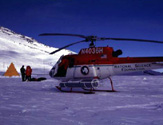
Helicopter support on Fang Glacier. Today we move to Lower Erebus Hut, our field station and home for the next three weeks.
(Pennycook)
|
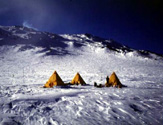
Before starting our work on Mt. Erebus
(12,000 ft) we must spend two days at an acclimation camp at 9000 ft. Here
our bodies will become accustomed to the altitude. Located on Fang Glacier,
we are sitting on 5000+ feet of ice. It is so peaceful here and remote,
a wonderful place to reflect on where we are and the forces of nature that
are all around us.
(Pennycook)
|
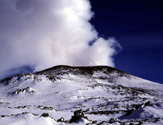
Mt. Erebus from our window inside Lower Erebus Hut.
(Pennycook)
|
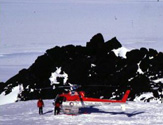
One of the remote seismic stations around the volcano. The station is on top of the rock outcrop behind the helicopter.
(Pennycook)
|

Another remote seismic stations on the side of the volcano. We are changing batteries in the equipment; the continent of Antarctica is in the background.
(pennycook)
|

Working on a seimsic station. (Mt.
Abbott) This station is far enough from the hut to need helicopter support
to reach it. Note Mt. Erebus with a beautiful plume in the background.
(Pennycook)
|

The crew is drilling a placement site for a sensitive GPS unit designed to measure the ground movement of the volcano. The continent of Antarctica is in the background.
(Pennycook)
|

Adjusting one of the seismometers around Mt Erebus.
(Pennycook)
|

These ice towers are formed when moist air from the volcano vents, hits the cold air of Antarctica and freezes.
(Pennycook)
|
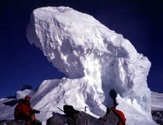
Another ice tower. Some were hollow
and could be explored.
(Pennycook)
|
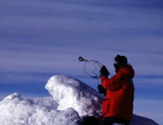
Testing the air vent on top of one of the ice towers for the gas composition. We found mostly water vapor and carbon dioxide.
(Pennycook)
|

Inside the towers, the sunlight shines blue through the ice. It is an extraordinary experience to be within these frozen walls.
(Pennycook)
|
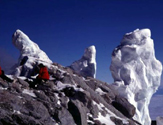
At the crater rim, with ice towers around us, we drop a gas sensor down into a vent below.
(Pennycook)
|
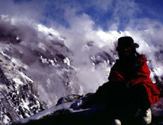
Jean Wardell at the crater rim. You can see the gases venting from inside the crater wall.
(Pennycook)
|
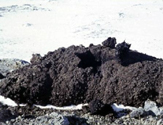
The volcano erupts sometimes twice a day. These lava bombs land on the crater rim and are full of feldspar crystals. The lava is fragile and wears away in time, leaving the crystals in piles on the ground.
(Pennycook)
|

The lava lake on the floor of the volcano crater. Here you can see the gases venting from the molten rock and about twice a day this lake erupts throwing the lava bombs onto the rim.
(Pennycook)
|

Mr. Erebus on a quiet day. No plume
is in evidence because of the low humidity.
(Pennycook)
|

. A glacier slowly moving its way off the Antarctica land mass into the frozen Ross Sea.
(Pennycook)
|

A Wedell seal enjoying a snooze on
the Ross Ice Shelf.
(Pennycook)
|


